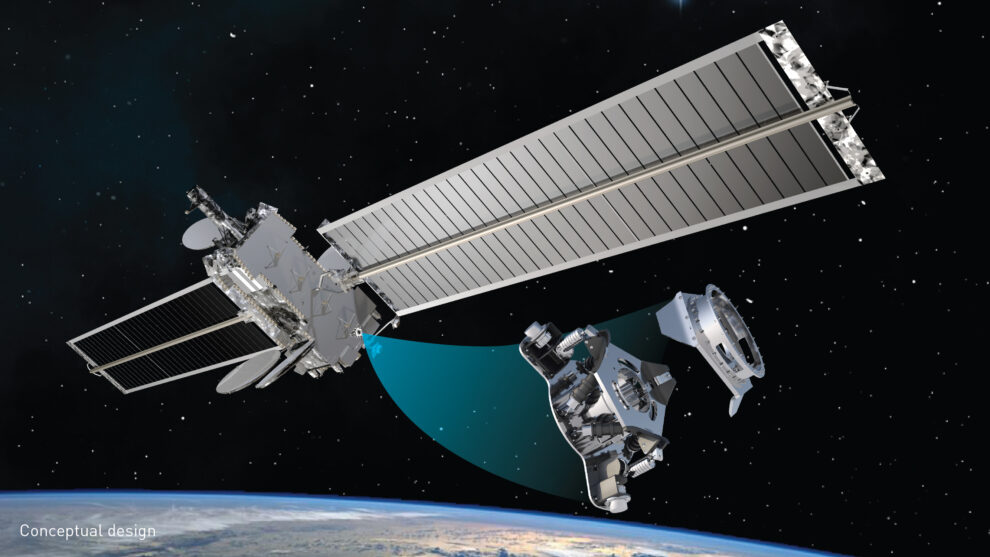In a groundbreaking development for military and commercial space operations, 2025 is set to mark the commencement of an ambitious on-orbit servicing mission, aimed at extending the life and enhancing the capabilities of geosynchronous satellites. Spearheaded by the Defense Advanced Research Projects Agency (DARPA) and executed in partnership with Northrop Grumman’s subsidiary, SpaceLogistics, this mission is not just a leap forward in space technology but a stride towards a new era of space utility and sustainability.
Key Highlights:
- Robotic Arms for Satellite Servicing: At the heart of this mission is DARPA’s Robotic Servicing of Geosynchronous Satellites (RSGS) program, featuring advanced robotic arms designed for a variety of tasks including inspections, repairs, and installation of propulsion jet packs.
- Space Force’s Involvement and Goals: The United States Space Force, recognizing the strategic importance of on-orbit capabilities, is keenly observing NASA’s OSAM-1 mission for insights into robotic refueling and potentially applying similar technologies for military satellites.
- Innovative Refueling Experiments: The Tetra-5 experiment, with a projected launch in 2025, aims to demonstrate satellite docking with a hydrazine depot in geostationary orbit, signifying a significant step towards operational in-orbit refueling.
- Commercial Partnerships and Capabilities: SpaceLogistics has emerged as a pivotal commercial partner, with its Mission Extension Vehicle (MEV) already demonstrating the feasibility of on-orbit satellite life extension. The forthcoming Mission Robotic Vehicle (MRV) aims to further these capabilities
- Military and Commercial Synergy: The U.S. military’s focus on enhancing satellite resilience aligns with commercial advancements in on-orbit servicing, indicating a future where military and commercial space operations are deeply interlinked.
The Future of On-orbit Servicing
The on-orbit servicing mission planned for 2025 stands at the convergence of military necessity and commercial innovation. With DARPA’s robotic technology and SpaceLogistics’ operational expertise, the mission aims to demonstrate the potential for extending the life of satellites, thus ensuring their longer utility in space. This capability not only promises to reduce space debris but also to enable more flexible and resilient satellite operations, critical for both national security and global communications.
The Importance of Collaboration
The collaboration between DARPA and SpaceLogistics underscores a broader trend towards leveraging commercial capabilities for government and military objectives. This partnership model may set a precedent for future space operations, highlighting the importance of synergy between the public and private sectors in advancing space technology and sustainability.
As we approach the launch of this landmark mission, the implications for space strategy and operations are profound. On-orbit servicing could revolutionize how we manage satellites, making space a more sustainable, flexible, and strategic domain. For military applications, the ability to repair and refuel satellites on-orbit not only enhances the longevity and value of space assets but also contributes to the operational security and effectiveness of space-based capabilities.
In sum, the on-orbit servicing mission planned for 2025 is more than a technical achievement; it represents a strategic pivot towards a new paradigm in space operations. By extending the life and enhancing the functionality of satellites, this mission could significantly amplify the strategic and commercial value of space assets, paving the way for a future where on-orbit servicing is a standard part of space operations.
This ambitious endeavor, bridging DARPA’s technological prowess with SpaceLogistics’ operational expertise, signifies a pivotal shift towards sustainable and strategic space operations, promising a future where satellites can be maintained, repaired, and refueled directly in space, ensuring their prolonged utility and reducing the risk of space debris. As the mission unfolds, it may well redefine the strategic landscape of space operations, heralding a new era of space utility and sustainability.








